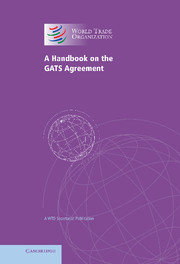Book contents
- Frontmatter
- Contents
- Preface
- Introduction
- 1 Basic purpose and concepts
- 2 Main building blocks: agreement, annexes and schedules
- 3 A closer look at domestic regulation
- 4 How the GATS is administered
- 5 The role and responsibilities of Member governments
- 6 The challenges ahead
- 7 Preparing requests and offers
- 8 Misconceptions about the GATS
- Appendix 1 Understanding your country's services trade
- Appendix 2 Relevant services statistics and classifications
- Annex: General Agreement on Trade in Services
- Index
Appendix 2 - Relevant services statistics and classifications
Published online by Cambridge University Press: 07 October 2011
- Frontmatter
- Contents
- Preface
- Introduction
- 1 Basic purpose and concepts
- 2 Main building blocks: agreement, annexes and schedules
- 3 A closer look at domestic regulation
- 4 How the GATS is administered
- 5 The role and responsibilities of Member governments
- 6 The challenges ahead
- 7 Preparing requests and offers
- 8 Misconceptions about the GATS
- Appendix 1 Understanding your country's services trade
- Appendix 2 Relevant services statistics and classifications
- Annex: General Agreement on Trade in Services
- Index
Summary
The ultimate purpose of trade liberalization, in whatever sectoral context, lies in its contribution to growth and development. Unfortunately, this contribution is far more difficult to trace than the immediate impact, not always positive, on the industries most directly affected. This is a particular concern in infrastructural services, which in many countries have long been protected from competition – to the apparent benefit of the service providers directly involved and, potentially, at the expense of overall economic expansion. However, it is not only the growth and efficiency effects that are difficult to capture; information gaps already exist at the sector level.
Given the non-tangible nature of many services, sector-specific trade data are more patchy than we are used to in agriculture, mining or manufacturing. (There may be some exceptions, such as transportat and tourism, where volume indicators are readily available.) However, the situation is gradually improving, owing in part to the impetus provided by the conclusion of GATS. After years of preparation, under the auspices of the United Nations Statistical Office (UNSO), the Manual of Statistics on International Trade in Services was completed in early 2002 (see www.un.org/Depts/unsd/class/techgrp.htm).
The manual extends the balance-of-payments-based definition of international services trade to reflect the four modes of supply. In particular, a new international framework – Foreign Affiliate Trade in Services statistics – provides guidance on the measurement of services provided through foreign-owned firms in host-country markets.
- Type
- Chapter
- Information
- A Handbook on the GATS AgreementA WTO Secretariat Publication, pp. 56 - 57Publisher: Cambridge University PressPrint publication year: 2005

